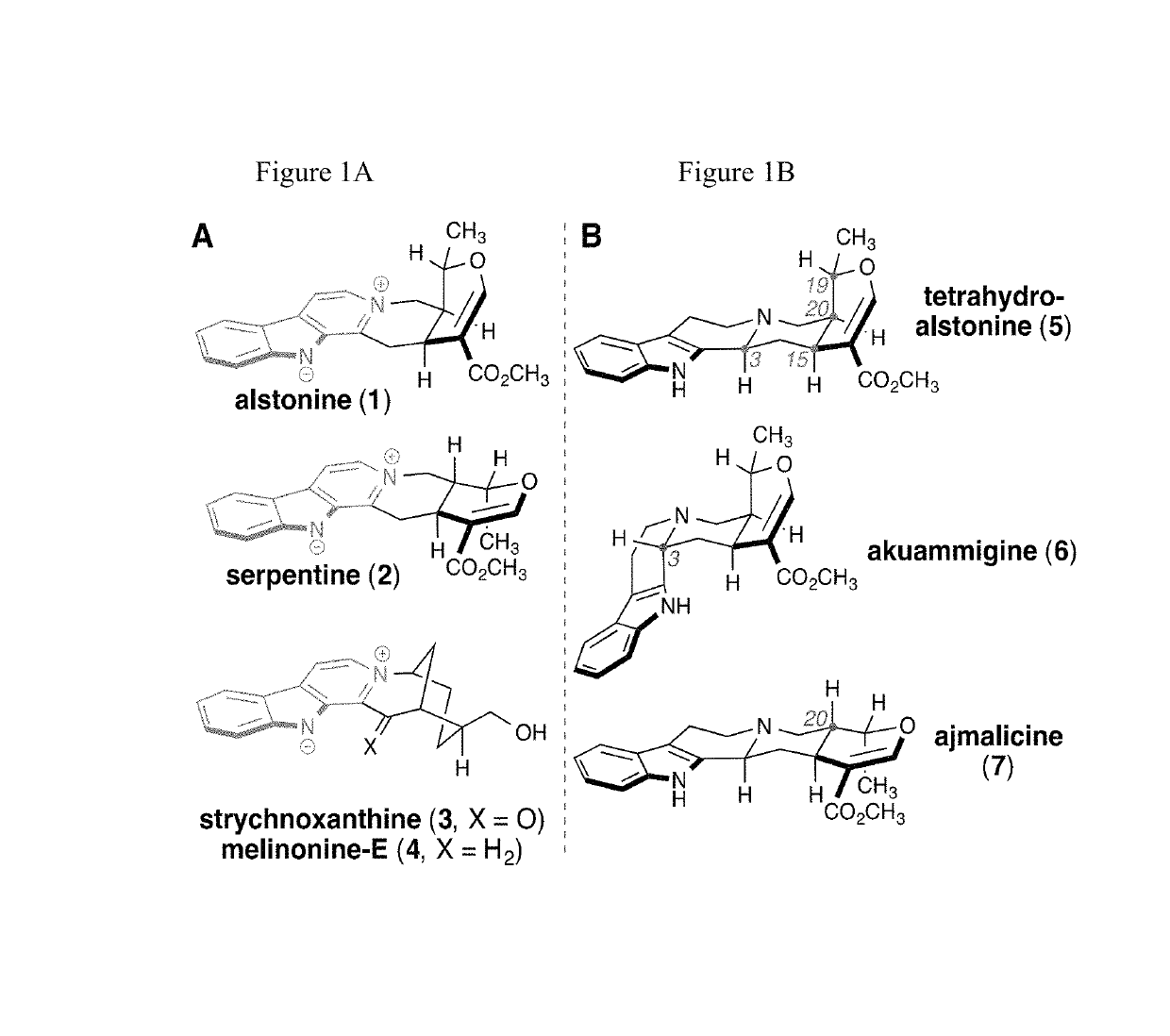Enantioselective syntheses of heteroyohimbine natural product intermediates
a technology of heteroyohimbine and natural product intermediates, applied in the field of enantioselective syntheses of heteroyohimbine natural product intermediates, can solve the problems of limited elucidation efforts, lack of purity, and no total syntheses of these specific compounds to da
- Summary
- Abstract
- Description
- Claims
- Application Information
AI Technical Summary
Benefits of technology
Problems solved by technology
Method used
Image
Examples
example 1
N-(3-Hydroxypropyl)-4-methylbenzenesulfonamide (I)
[0042]
[0043]To a cooled (0° C.) mixture of 3-aminopropan-1-ol (1.9 mL, 24.8 mmol) and Et3N (6.9 mL, 49.6 mmol, 2.0 equiv) in chloroform (4.0 mL) was added a solution of p-toluenesulfonyl chloride (5.21 g, 14.38 mmol, 1.1 equiv) in chloroform (6.0 mL, 2.5 M overall). The mixture was allowed to slowly warm to ambient temperature and stir under inert atmosphere for 18 h. The reaction was then quenched with 5% NaHCO3, and the mixture was extracted with EtOAc (×3). The combined organic layers were washed successively with 5% citric acid, water, 5% NaHCO3, and brine. Then the organic layers were dried over MgSO4, filtered, and concentrated in vacuo to provide N-(3-hydroxypropyl)-4-methylbenzenesulfonamide (5.70 g, 24.8 mmol, 99% yield). Carried on to next step without further purification.
[0044]Analytical data for I: 1H NMR (400 MHz, CDCl3) δ 7.76 (d, J=8.3 Hz, 2H), 7.35-7.29 (m, 2H), 5.62 (t, J=6.1 Hz, 1H), 3.70 (t, J=5.8 Hz, 2H), 3.07 (q...
example 2
4-Methyl-N-(3-oxopropyl)benzenesulfonamide (II)
[0045]
[0046]To a mixture of N-(3-hydroxypropyl)-4-methylbenzenesulfonamide (1.15 g, 5.00 mmol), TEMPO (0.078 g, 0.50 mmol, 0.10 equiv), NaIO4 (1.77 g, 8.25 mmol, 1.65 equiv) and NaBr (0.085 g, 0.825 mmol, 0.165 equiv) was added CH2Cl2 / H2O (45:55, 20.0 mL, 0.25 M). The resulting biphasic mixture was heated to 35° C. Upon completion of the reaction (18 h; monitored by TLC), the organic layer was separated, and the aqueous layer was extracted with CH2Cl2. The combined organic layers were concentrated in vacuo, and the residue was partitioned between EtOAc and sat. aq. Na2S2O3. The organic layer was then washed successively with H2O and brine, dried over MgSO4, filtered, and concentrated in vacuo. Purification by column chromatography (40:60 to 50:50 EtOAc / hexanes) provided 4-methyl-N-(3-oxopropyl)benzenesulfonamide (0.903 g, 3.97 mmol, 79% yield) as a yellow oil.
[0047]Analytical data for II: 1H NMR (500 MHz, CDCl3) δ 9.73 (s, 1H), 7.74 (d,...
example 3
Methyl (E)-5-((4-methylphenyl)sulfonamido)pent-2-enoate (III)
[0048]
[0049]To a cooled (0° C.) solution of methyl 2-(dimethoxyphosphoryl)acetate (8.8 mL, 54.4 mmol) in THF (253 mL) was added sodium hydride (6.73 g, 280 mmol, 5.15 equiv) portion-wise. The resulting thick white reaction mixture was stirred for 60 min, then a solution of 4-methyl-N-(3-oxopropyl)benzenesulfonamide (9.89 g, 43.5 mmol, 0.80 equiv) in THF (110 mL, 0.12 M overall) was added via cannula. Upon completion of the reaction, H2O was added to quench, and the organic solvent was removed in vacuo. The remaining aqueous mixture was extracted with EtOAc, and the combined organic layers were dried over MgSO4, filtered, and concentrated in vacuo. Purification by column chromatography (20:20:60 to 25:25:50 CH2Cl2 / Et2O / hexanes) provided methyl (E)-5-((4-methylphenyl)sulfonamido)pent-2-enoate (7.73 g, 27.3 mmol, 63% yield) as a yellow oil.
[0050]Analytical Data for III: 1H NMR (500 MHz, CDCl3) δ 7.72 (d, J=8.0 Hz, 2H), 7.30 (...
PUM
| Property | Measurement | Unit |
|---|---|---|
| time | aaaaa | aaaaa |
| temperature | aaaaa | aaaaa |
| temperatures | aaaaa | aaaaa |
Abstract
Description
Claims
Application Information
 Login to View More
Login to View More - R&D
- Intellectual Property
- Life Sciences
- Materials
- Tech Scout
- Unparalleled Data Quality
- Higher Quality Content
- 60% Fewer Hallucinations
Browse by: Latest US Patents, China's latest patents, Technical Efficacy Thesaurus, Application Domain, Technology Topic, Popular Technical Reports.
© 2025 PatSnap. All rights reserved.Legal|Privacy policy|Modern Slavery Act Transparency Statement|Sitemap|About US| Contact US: help@patsnap.com



